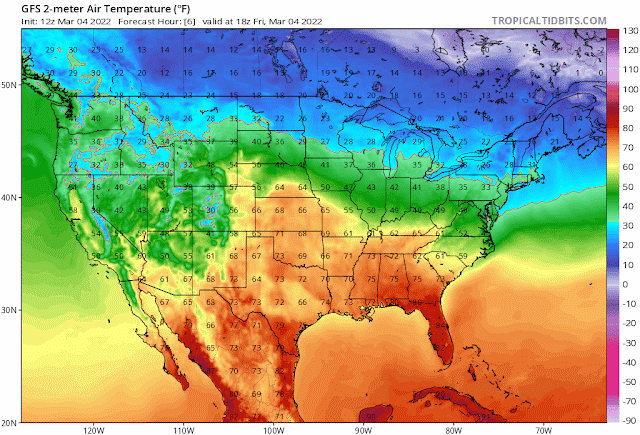The high temperature tomorrow will be 72. That's just perfect! Get out and enjoy yourselves but remember that winter is not over.
Projected temperatures for March 13
Projected temperature for April 3
Snow on March 8?
Snow on March 12?
Overall trends in temperatures and precipitation for the next 12 days
From the National Weather Service:
.Long Term...(Sunday through Friday) Issued at 258 PM EST Fri Mar 4 2022 Early Sunday, mid-upper level shortwave trough now over southern California is expected to be over the Great Lakes. Warm advection- driven precipitation regime should be well to our northeast, and midlevel dry conveyor belt will have overspread Indiana by then. Residual precipitation should be relegated south and east of our area associated with warm conveyor belt and anomalous integrated water vapor transport values. Westward of the deeper saturation/precipitation but ahead of lagging surface front, low level moisture may be sufficient enough for lingering drizzle and low clouds early Sunday. By midday, the front will be southeast of the area but will be increasingly flow-parallel and thus progressing much slower. Meanwhile, increased mixing and deepening PBL amidst departing low level jet will probably result in windy conditions at least for a period midday through mid-afternoon. Given the path of this first shortwave trough, cold advection should be relegated to higher latitudes with above normal temperatures continuing Sunday afternoon. A deeper/broader trough will approach Sunday night into Monday. Deterministic model variances and spread among ensemble members is greater than the first wave but still relatively low given the time range, and so forecast confidence at this time range is at least average. There has been some run-to-run variability on axis of heaviest QPF, and this has important implications for how river basins are impacted and what the result will be for main stem flooding. 14-day precipitation anomalies across southern Indiana are slightly positive, as well as latest NASA SPoRT soil moisture values. RFC 6-hour flash flood guidance values are generally in the 2.25-3.00 inch range, with smaller scale depressed areas under 2.00 inches over a small area of southeast Indiana, including Decatur County. So, we`ll have to watch for the potential for flooding across southern Indiana. Shear is substantial with 70+ knot low-level jet and effective shear values >60 knots, however instability for deep/robust convection is limited. Along with the uncertainty on placement of the heaviest QPF, the northward reach of the warm sector (i.e., amplitude of the frontal wave) brings a higher degree of uncertainty for temperatures Monday. NAM is further north with QPF and warm sector compared to ECMWF/EPS and GFS/GEFS. Model guidance has various depictions of a second shortwave trough late Monday into Tuesday. Subsidence and mid-level drying behind the first shortwave leaves a relatively shallow layer of moisture ahead of this second shortwave. Thermal profiles may be marginally supportive of snow if magnitude of ascent and moisture is enough for precipitation late Monday or Monday evening. Overall amounts will be light if this occurs at all. Low-amplitude southern stream shortwave trough will approach the area by mid-week bringing low probabilities for measurable precipitation. Thermal profile may be marginally supportive of snow for at least a brief period. This will be in a period of greater uncertainty, however, so we will not convey much detail at this time range. Further refinements to the forecast will be made as model spread lessons over the next couple of days.






No comments:
Post a Comment